|
Africa Trip -
September 2010
South Africa - Botswana - Zambia
|
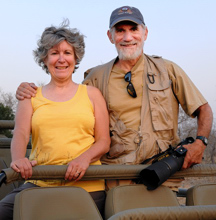 |
|
Africa Trip -
September 2010
South Africa - Botswana - Zambia
|
 |
Botswana - Camp Okavango (9/8-10/10)
|
|
| While much
of Botswana is desert, the northwest corner of the country is flooded
every year by the Okavango river that carries the water from heavy rains
in the mountains of Angola, 1200 kilometers away. The waters spread out
across the flat desert to form the intricate channels and islands of the
Okavango Delta which is a natural reserve for all types of African
wildlife. There are no continuous roads through the Delta, so travel is
either by boat or airplane. Accommodations for visitors within the delta
are in lodges located on some of the larger islands within the delta. As
with all these lodges, the one we stayed at, Camp Okavango on Naxaragha
island, had it's own
airstrip for shuttle planes. As it turned out though, the year we were
there was a particularly high water year and the airstrip at Camp
Okavango was flooded. This meant that we had to fly in from Xini camp to
a dry strip about twenty miles from Camp Okavango lodge and then travel
by boat through the papyrus lined channels of the delta. Our short
flight over the delta really gave us a great view of alternating wet and
dry areas of the delta and we spotted elephant, buffalo and giraffe as
they grazed on the islands. The boat ride gave us a great introduction
to the waterways of the delta that were teaming with wild water birds.
Click on map for
interactive Google map
Camp Okavango is located on an island in idyllic setting of large trees. The central dinning and lounge area are surrounded by well furnished tent cabins. The cabins were luxurious with comfortable beds and large rooms and plush showers. Weaver birds had their nests in the trees and small ???? owls roosted in the branches. The meals were marvelous and the young staff were energetic and gave us excellent service. One night we were even entertained by native singing and dancing put on by the lodge staff. On our first afternoon after we settled in, we went out on canoes through the reed marshes that surround the island. Our guides pointed out the vegetation, birds and the small reed frogs that populated the marshes. We did a lazy circle of the marshes and returned to the island for a beautiful sunset and sundowner refreshments. The next day we got an early start after a great breakfast and headed out into the papyrus channels on two motorized skiffs. As we cruised the maze of channels, water birds such as Pied Kingfishers, Cormorants, and Herons escorted us for short stretches offering great photo opportunities. Our first destination was one of the large islands in the delta. These islands are inhabited by all sorts of wildlife with only the occasional visit by a tour group. After landing on the island, we had our first opportunity to walk in the bush with our guides carrying rifles just in case. We hiked through the Mopane trees and dry grass and clicked away at a herd of impala, a lone wildebeest, and a troop of baboons that resided on the island. We also spent some time at a large Baobob tree and saw the bright crimson flowers of Sausage Trees that grow all over the island. Shortly after we left the island we cam across a good sized crocodile resting on the bank of a channel and when we slowed down to get some pics, it made a mad dash for the water with lots of splashing water in it's wake. We made another stop for lunch on another island and then cruised slowly back to Camp Okavango where we spent the rest of the afternoon exploring the grounds and catching up on charging batteries and downloading files. The day finished with another great dinner and conversation around the dinner table. We headed back out of the deep delta the next day on the skiffs. We followed one of the large channels of the Okavango River back toward the drier part of the delta area. This leg of the trip was a birders delight. We passed through a number of large lagoons that were the home to many aquatic birds. In one lagoon we spent time observing and shooting a mixed rookery of Malibu Storks, Yellow-billed Storks and Sacred Ibis. Birds were not the only wildlife we saw. The great thing about cruising the narrow papyrus channels was coming around a bend and surprising wildlife on the banks. The best time this happened was when we surprised a big bull elephant that was just starting to cross the channel in front of us as we came aroung a sharp bend. This big boy was not happy with our presence and did a lot of trumpeting and splashing at us. It was a very thrilling incident. At another bend we just glimpsed a large croc diving in the channel. After lunching at a clearing on an island in one of the lagoons, we were treated to one of the several very informative talks given by our leader Adam on the geography and history of the area. Finally, in the afternoon we arrived at Xakanaxa Lagoon where we rejoined our mobile safari vehicles which had made a circuitous trek on dry roads. We finished the day with a game drive to our camp in the Xakanaxa reserve area. |
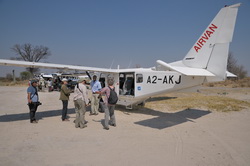 Bush plane flight  Dock at Camp Okavango  Canoeing in reeds 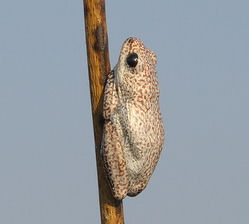 Reed frog 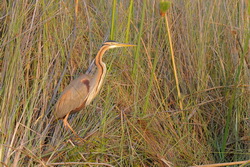 Purple Heron 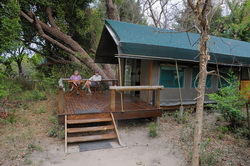 Tent cabin 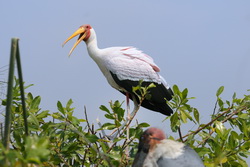 Yellow-billed Hornbill 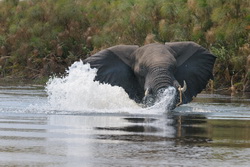 Charging elephant |
| Slideshow |
|
|
|
|
|
|
|
|
|